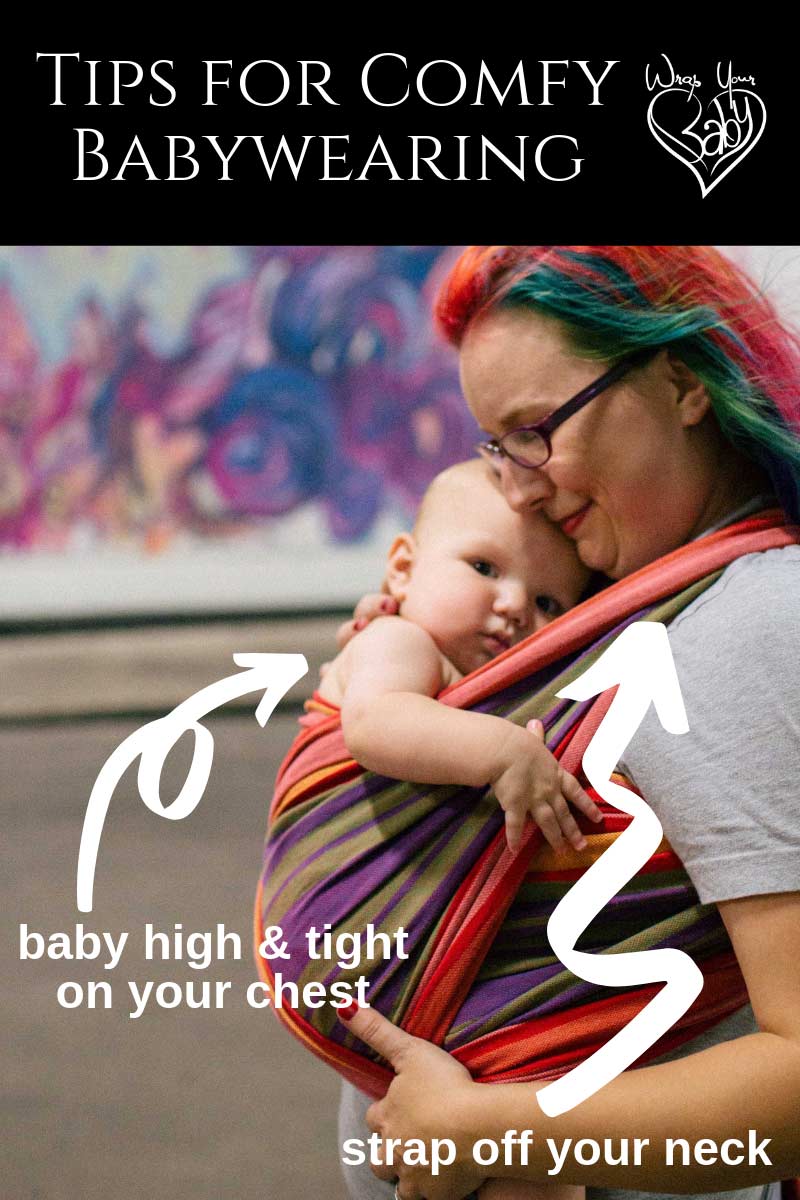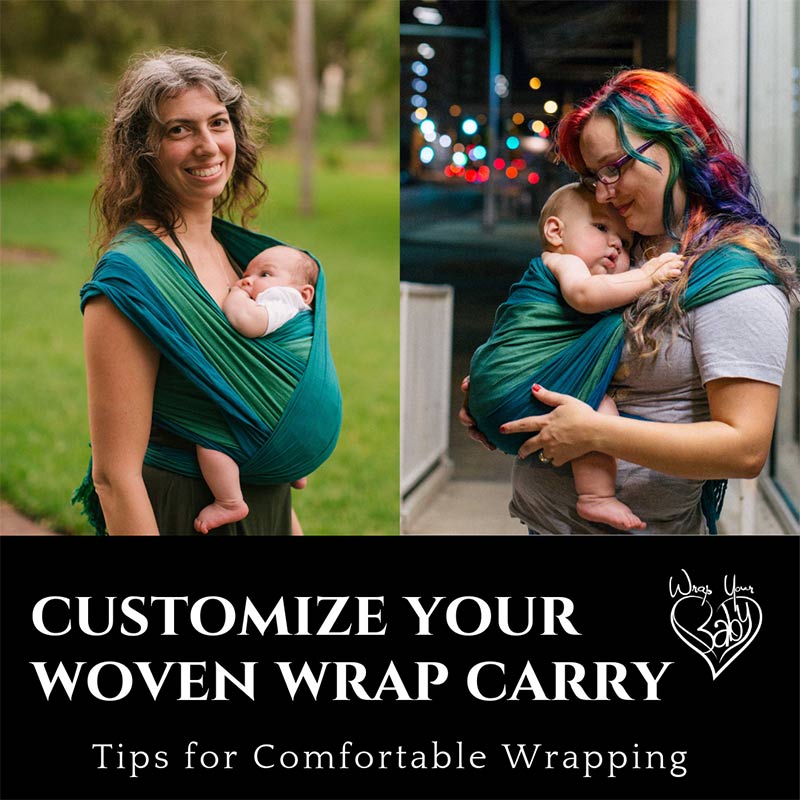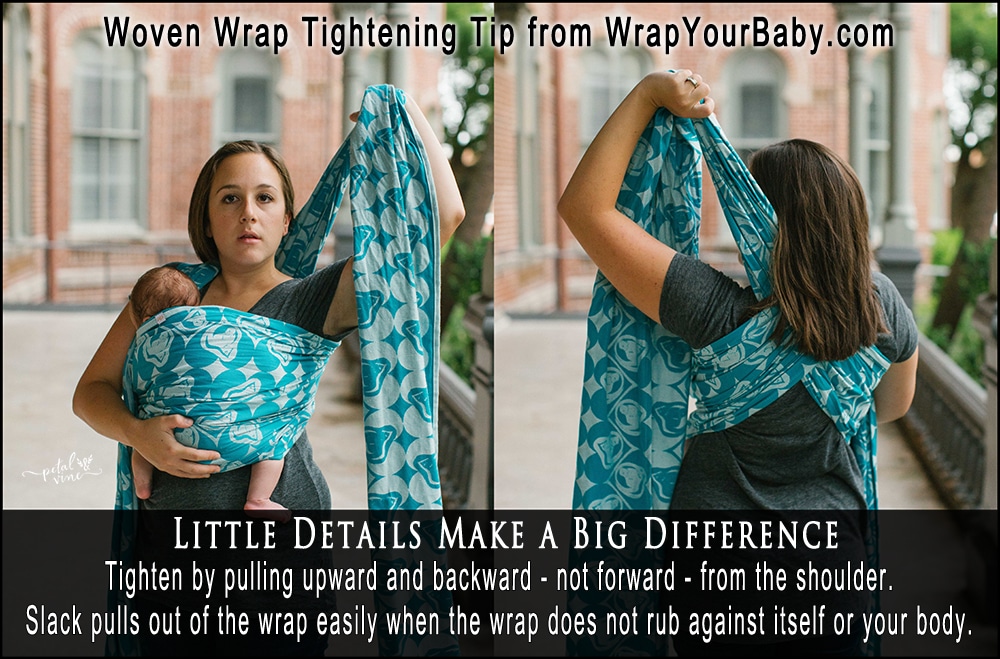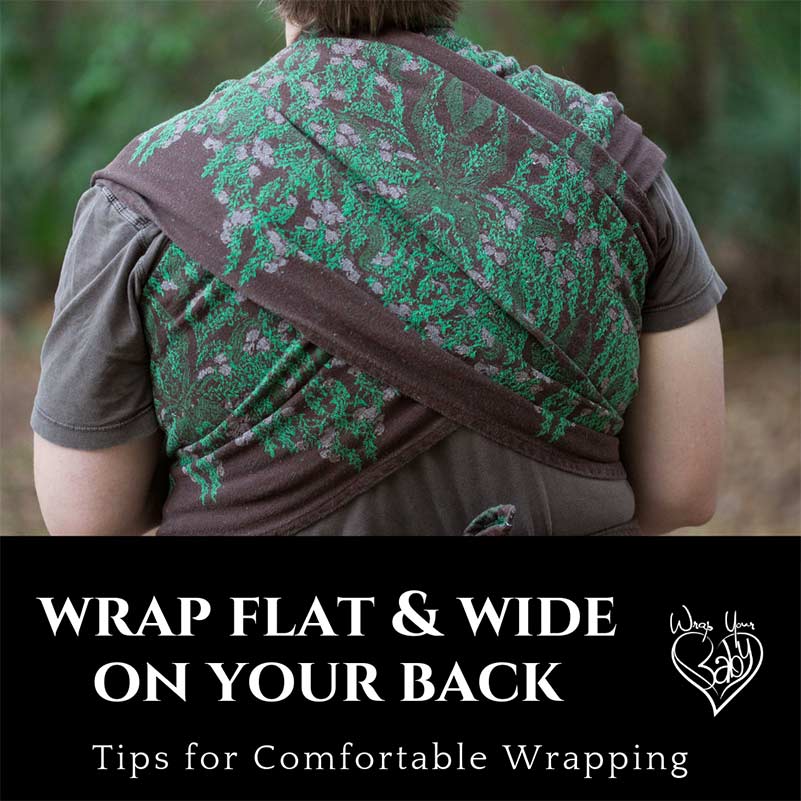Comfortable Babywearing Without Shoulder Pain
5 Rules of Comfortable Babywearing

Babywearing shouldn’t hurt!
This isn’t the act of a martyr mom – doing what’s best for her baby at her own expense.
A good baby carrier should make your life easier and better and more comfortable.
So what if it does hurt?
First rule of comfortable babywearing: choose a customizable carrier.
I teach woven wraps because they are an infinitely adjustable carrier. Wraps are customized to you every time you put it on. They fit every body type and size. And they can be used in so many different ways to work around any specific injury or pain.
Because of this versatility, you don’t have to worry about trying out a number of different carriers to see how they fit your exact body and needs.
Instead you wrap the wrap around you to fit your exact body and needs each time. And you wrap to your own comfort even if your body and needs change daily. Or, more likely, your baby’s do. Because that baby is a different size and shape every week. And has different preferences and requirements all the time. What’s working today may work for a week or a month. But this too shall pass and you’ll find that something else works for your baby now.
NOTE: facing outward in any wrap or baby carrier will not be as comfortable. Our bodies are designed to have baby oriented toward us (heart to heart). But you can do forward facing when it’s the best solution and there are other ways to give your baby a view.
Second rule of comfortable babywearing: high and tight!
If you wrap your baby high and tight on your chest, it will not pull on your shoulders.
If there is slack in the wrap job, then that can result in baby’s weight hanging from your shoulders. This gets very heavy (like a backpack) and definitely uncomfortable. Instead, aim for having your baby wrapped against your torso snuggly. This will feel more like gaining 15 lbs than carrying 15 lbs! The weight should be distributed to your entire torso.
I recommend Front Wrap Cross Carry (FWCC) as a good, supportive carry. It’s a great carry to learn first. And you want to get that snugness I’m talking about. Make sure the initial pass around baby is good and snug by pulling as much as needed on the shoulder straps. Only then cross the passes and complete the wrap job.
Third rule of comfy babywearing: no straps on your neck!
In any baby carrier, if the straps holding your baby’s weight runs too close to your neck, you will feel baby’s weight pulling on your neck and that is not comfortable!
When wrapping, don’t let the shoulder strap lay too close to your neck. Instead, position the wrap on your shoulder a comfortable distance from your neck.
If you’ve already wrapped and find the wrap inching toward your neck, simply grab the bunched up wrap and pull it away from your neck to lay on your shoulder farther from your neck. And if it won’t stay, try flipping the edge of the wrap that is closest to your neck and folding over the ball of your shoulder to hold it in place.
Fourth rule of comfy babywearing: spread wide and flat.
Don’t twist the wrap where it spreads over you. Make sure the top rail (edge) remains the top rail and spread the wrap wide and flat over your back and around your sides.
Keeping the wrap spread and tightened evenly means there will not be any pressure points that can dig into you uncomfortably.
Woven wraps are surprisingly wide and this width helps distribute your baby’s weight across your entire torso. Much more comfortable than a carrier with narrow straps like a backpack.
Woven wraps are quite wide. So there may be some bunching to fit your back, or where it spreads across your baby. That is just fine and you do not need to worry about that. Just make sure as you tighten your wrap you do so evenly so no one strand along the width is tighter than others.
Here’s a video from Wraplena showing how to do strand-by-strand tightening to get all the slack out evenly:
Fifth rule of comfy babywearing: customize to your specific needs.
If you are following all the above rules and are having discomfort, it’s time to customize.
With a woven wrap you have lots of different carry options and each one distributes weight differently.
For example, Front Wrap Cross Carry (FWCC) is the most popular front carry and generally very supportive and comfortable (if following all the above rules). But you may have a back or shoulder pain that is exacerbated by this carry, a. In that case, a different carry can absolutely make all the difference. Since all our bodies are different and if you don’t love the comfort or achieve “weightlessness” with FWCC, then try finding a carry that you will love.
If you have a sensitive shoulder, you can do a one shoulder carry. That way there is no weight on your bad shoulder. Try a hip carry and either wear your baby on your hip (best for 3 months and older) or use the same carry but centered on your chest for a one-shouldered front carry.
You can also do a torso carry that has no shoulder straps at all but wraps around your sides.
Troubleshooting: Other Wrap Tweaks
If baby is leaning away, tighten your top rail.
If baby is leg-straightening to pop the seat (so the wrap comes out from under baby’s bottom), try a carry with a cross pass that spreads between baby’s legs or alter the carry you are doing to include a cross pass.
If baby’s weight is pulling on your shoulders, wrap tighter and snugger. Practice finding hidden slack to pull it out of the wrap before tying.
If you have a back or shoulder condition, a back carry is often more comfortable than a front carry.
If your baby is frustrated in the baby carrier and seems not to want to be held tightly, try wrapping baby with arms out of the wrap so they have more freedom.
If you or baby get too hot, try a cooler carry – one with fewer passes over baby. Or you can bunch the crosses in Front Wrap Cross Carry to baby’s side instead of spread over baby.
If you can’t seem to keep the wrap from digging into your neck, consider doing a strategic twist in the wrap just below your shoulder. That way the top rail (edge) becomes the bottom rail. You can see how I do that in this Back Wrap Cross Carry (BWCC):
Speaking of BWCC, a lot of people only know how to do it with a half knot at the chest. Some people do not like that chest knot. It is not comfortable or digs in. In this case, try doing the standard Back Wrap Cross Carry with the wrap crossed over your chest as in the above video.
If you find a carry that you like, but something about it is uncomfortable, you can adjust that one thing without changing the rest. This is the way you really customize the wrap to you. Learn the different kinds of wrap passes and how each one feels and what function in the carry it accomplishes.
Learn the Different Woven Wrap Passes and How to Use Them
A horizontal pass or torso pass wraps around your torso and under both arms.
A cross pass comes from over your shoulder and crosses between baby’s legs to come around your opposite side. This pass makes it impossible for your baby to pop the seat of your carry because there is no way to squirm out of a cross pass.
A sling pass (formerly called a rebozo pass) comes similarly from over your shoulder and around your opposite hip but instead of crossing between baby’s legs, it goes over both baby’s legs and curves under to form a seat before coming around the parent’s side. This is a great pass to reign in babies who like to lean back. This pass spread high on baby’s back will hold their upper torso close to yours.
Find the use for each pass in this playlist of different wrap passes. Use these wrap passes in front or back carries. Use the menu in the upper left corner to choose the pass you need help with, or just let it play to cycle through all the main wrap passes used in woven wrapping:
You can usually easily change a cross pass to a sling pass in any carry. You can just as easily change a sling pass to a cross pass. Sometimes your baby’s tendencies will call for one or the other. If you have a leaner and a seat-popper, you may want one cross pass and one sling pass.
For example, your baby may be leaning too much in the Front Wrap Cross Carry (FWCC). Make the last pass of FWCC a sling pass instead of a cross pass. You will keep baby upright against you much better.
Reach out to me for help tweaking your wrap carry:
There are really endless ways to tweak your wrap carry to your needs so if you need help with something about your carry that’s bothering you, please email me: diana@wrapyourbaby.com
I will help you figure out how to alter it to your needs!





Leave a Comment